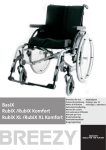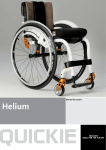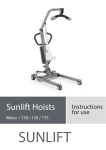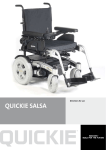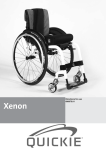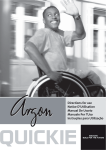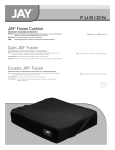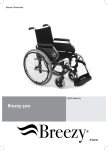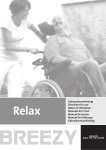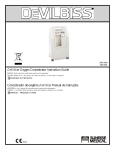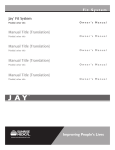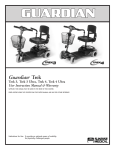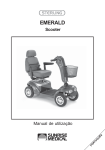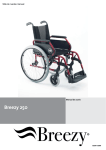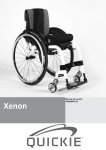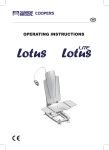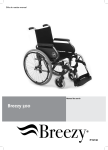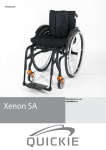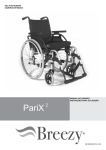Download Helium User Manual
Transcript
Helium Directions for use 2 Helium Rev. 1 Table of contents Dear Customer, We are very pleased that you have decided in favour of a highquality SUNRISE MEDICAL product. This Owner’s manual will provide numerous tips and ideas so that your new wheelchair can become a trustworthy and reliable partner in your life. For Sunrise Medical, it is very important that we have a good relationship with our customers. We like to keep you up-to-date about new and current developments at our company. Keeping close to our customers means: fast service, as little red tape as possible, working closely with customers. When you need replacement parts or accessories, or if you just have a question abour your wheelchair – we are there for you. We want you to be satisfied with our products and service. At Sunrise Medical we are constantly working to develop our products further. For this reason, changes can occur in our palette of products with regard to form, technology, and equipment. Consequently, no claims can be construed from the data or pictures contained in this Owner’s manual. The management system of SUNRISE MEDICAL is certified to EN ISO 9001, ISO 13485 and ISO 14001. As the manufacturer, SUNRISE MEDICAL, declares that the lightweight wheelchairs conform to the 93/42/EWG guideline. Please contact your local, authorised SUNRISE MEDICAL dealer if you have any questions regarding the use, maintenance or safety of your wheelchair. In case there is no authorised dealer in your area or you have any questions, contact Sunrise Medical either in writing or by telephone. Foreword about wheelchairs General safety notes and driving limits . . . . . . . . . . . . . . . . . . . 4 – 5 Guarantee . . . . . . . . . . . . . . . . . . . . . . . . . . . . . . . . . . . . . . . . . . . . 5 Wheelchair components . . . . . . . . . . . . . . . . . . . . . . . . . . . . . . . . . 6 Handling . . . . . . . . . . . . . . . . . . . . . . . . . . . . . . . . . . . . . . . . . . . . . 7 Step tubes . . . . . . . . . . . . . . . . . . . . . . . . . . . . . . . . . . . . . . . . . . . . 7 Brakes . . . . . . . . . . . . . . . . . . . . . . . . . . . . . . . . . . . . . . . . . . . . . . . 7 Footplates . . . . . . . . . . . . . . . . . . . . . . . . . . . . . . . . . . . . . . . . . . . . 8 Castors . . . . . . . . . . . . . . . . . . . . . . . . . . . . . . . . . . . . . . . . . . . . . . 8 Seat . . . . . . . . . . . . . . . . . . . . . . . . . . . . . . . . . . . . . . . . . . . . . . . . . 8 Wheel alignment . . . . . . . . . . . . . . . . . . . . . . . . . . . . . . . . . . . . 8 - 9 Backrest . . . . . . . . . . . . . . . . . . . . . . . . . . . . . . . . . . . . . . . . . . . . . .9 Push handles . . . . . . . . . . . . . . . . . . . . . . . . . . . . . . . . . . . . . . . . . . 9 Lap belt . . . . . . . . . . . . . . . . . . . . . . . . . . . . . . . . . . . . . . . . . . 10 - 11 Anti-tip tubes . . . . . . . . . . . . . . . . . . . . . . . . . . . . . . . . . . . . . . . . . 10 Crutch holder . . . . . . . . . . . . . . . . . . . . . . . . . . . . . . . . . . . . . . . . . 10 Tyres and mounting . . . . . . . . . . . . . . . . . . . . . . . . . . . . . . . . . . . . 11 Maintenance and care . . . . . . . . . . . . . . . . . . . . . . . . . . . . . . . . . . 11 Trouble-shooting . . . . . . . . . . . . . . . . . . . . . . . . . . . . . . . . . . . . . . 12 Disposal / Recycling of materials . . . . . . . . . . . . . . . . . . . . . . . . . .12 Nameplate . . . . . . . . . . . . . . . . . . . . . . . . . . . . . . . . . . . . . . . . . . . 12 Technical data . . . . . . . . . . . . . . . . . . . . . . . . . . . . . . . . . . . . 13 - 15 Torque . . . . . . . . . . . . . . . . . . . . . . . . . . . . . . . . . . . . . . . . . . . . . . 16 Notes . . . . . . . . . . . . . . . . . . . . . . . . . . . . . . . . . . . . . . . . . . . . . . . 17 Sunrise Medical Limited High Street, Wollaston West Midlands DY8 4PS Telephone: 01384 44 66 66 Telefax: 01384 44 66 99 E-mail: [email protected] Internet: www.sunrisemedical.co.uk Use IMPORTANT: DO NOT USE YOUR WHEELCHAIR UNTIL THIS MANUAL HAS BEEN READ AND UNDERSTOOD. Wheelchairs are exclusively for a user who is unable to walk or has limited mobility, for their own personal use. Warranty can only be taken on if the product is used under the specified conditions and for the intended purposes. The expected life of the wheelchair is 5 years. DO NOT fit or use replacement parts from other manufacturers with this wheelchair. The range of fitting variants as well as the modular design mean that it can be used by those who cannot walk or have limited mobility because of: • Paralysis • Loss of extremity (leg amputation) • Extremity defect/deformity • Joint contractures/joint injuries • Illnesses such as heart and circulation deficiencies, disturbance of equilibrium or cachexia. When considering provision, please also note the body size, weight, physical and psychological constitution, the age of the person, living conditions and environment. Helium Rev. 1 3 ENGLISH Foreword General safety notes and driving limits The construction of this wheelchair, as well as the technology used, is designed to give the maximum level of safety. International safety standards currently in force have either been fulfilled or exceeded in parts. Nevertheless, users may put themselves at risk by improperly using their wheelchairs. For your own safety, the following rules must always be observed. ENGLISH Unprofessional or erroneous changes or adjustments increase the risk of accident. As a wheelchair user, you are also part of the daily traffic on streets and pavements, just like anyone else. We would like to remind you that you are, therefore, subject to any and all traffic laws. Maximum user weight: 120 kg. Please note the weight limits for separately fitted lightweight options. This wheelchair should be used exclusively to convey one person at a time. Any other use beyond this limit is in violation of safety regulations. Your wheelchair is not suitable for use in vehicles. DO NOT sit on the wheelchair during any transportation in a vehicle; always use a properly secured vehicle seat!! Be careful during your first ride in this wheelchair. Get to know your wheelchair. Only permanently installed seats and seat belts will offer sufficient protection in hazardous situations. Before each use, the following should be checked: • Quick-release axles on the rear wheels • Velcro on seats and backrests • Tyres, tyre pressure and wheel locks. When vehicles are in motion, unoccupied wheelchairs should be secured using appropriate means. Before changing any of the adjustments of this wheelchair, it is important to read the corresponding section of the Owner’s manual. It is possible that potholes or uneven ground could cause this wheelchair to tip over, especially when riding uphill or downhill. Before changing any of the adjustments of this wheelchair, it is important to read the corresponding section of the Owner’s manual. When riding over a step or up an incline frontally, the body should be leaning forward. > 10° > 10° 4 Helium Rev. 1 Danger! Secure your wheelchair on uneven ground or when transferring (e.g. into a car) by using the brakes. Danger! For high amputees you must position the rear wheels towards the back and/or use anti-tip tubes. Danger! With active centre of gravity adjustment, the wheelchair may tip over, so anti-tip tubes should be used. Danger! Before setting off, check that your tyre pressure is correct. The correct tyre pressure is printed on the edge of the wheel, for rear wheels it should be at least 3.5 bar ( 350 kPa). All brakes will only work if there is sufficient tyre pressure and if the correct setting has been made (see the Chapter on "Brakes"). Danger! The wheel locks are not intended to brake your wheelchair. They are only there to ensure that your wheelchair does not begin rolling unintentionally. When you stop on uneven ground/floors, you should always use the wheel locks to prevent such rolling. Always apply both wheel locks, otherwise your wheelchair could tip over. Caution! The wheel locks have not been designed to be used as brakes for a moving wheelchair. Always make use of elevators and ramps. If these are not available, you can reach your destination with the aid of two attendants. They should grip the wheelchair at securely mounted parts. If your wheelchair is equipped with anti-tip tubes, these should be folded away. A wheelchair should never be lifted with an occupant; it should only be pushed. Danger! Do not lift or carry your wheelchair on back tubes or push handles. Danger! If the seat and back sling are damaged, you must replace them immediately. Danger! Be careful with fire, in particular with burning cigarettes. Seat and back slings can set on fire. Danger! To avoid injuries to the hand when operating the wheelchair, do not grip between the rear wheel and brakes. Danger! If a journey in a specially fitted vehicle for disabled people is required, the user should use the seats in the vehicle and the appropriate restraint system. Danger! Always make sure that the quick-release axles on the rear wheels are set properly. If the button on the quick-release axle is not pressed in, the rear wheel cannot be removed. Note: This guarantee cannot be transferred. 4) The guarantee also covers all repaired or replaced parts for the remaining period of the guarantee for the wheelchair. 5) For spare parts which are fitted after the start of the original guarantee, we give a further 24-month guarantee. 6) Consumable parts are normally excluded from the guarantee, except in the case that premature wear of the part is the direct result of a manufacturing fault. These parts include, amongst others, upholstery, tyres, inner tubes and similar parts. 7) The guarantee conditions above cover all product parts for models which were purchased at full sales price. 8) Normally we do not accept responsibility if a repair or replacement of the wheelchair is required for one of the following reasons: a) The product or part has not been maintained or serviced in accordance with the manufacturer's recommendations as shown in the User Instructions and/or the Service Instructions. Accessories have been used which are not specified as original accessories. b) The wheelchair or a part of the wheelchair was damaged through neglect, accident or improper use. c) Alterations to the wheelchair or parts, which are not in accordance with the manufacturer's specifications or the carrying out of repairs before informing the authorised dealer. Operating conditions: The wheelchair can be used indoors as well as outdoors on dry, relatively smooth surfaces. It should not be used in heavy rain, on snow-covered and/or slippy surfaces. Guarantee Guarantee THIS DOES NOT AFFECT YOUR LEGAL RIGHTS IN ANY WAY. Guarantee conditions 1) Repair or replacement is carried out by the authorised Sunrise Medical dealer. 2) To fulfil the guarantee conditions, should servicing need to be carried out on your wheelchair under this agreement, contact the designated Sunrise Medical authorised dealer immediately, with precise details on the type of difficulty. Should you be using the wheelchair outside the area covered by the designated Sunrise Medical authorised dealer, the work will be carried out under "guarantee conditions" by another dealer as designated by the manufacturer. 3) Should a part or parts of the wheelchair require repair or replacement within 24 months (5 years for frame and cross-brace) Helium Rev. 1 5 ENGLISH Danger! In particular when using lightweight metal handrims, fingers will easily become hot when braking from a high speed or on long inclines. Danger! If the wheelchair is subject to direct sunlight for a long period of time, then parts of the wheelchair (e.g. frame, legrests, brakes and sideguard) may become hot (>41°C). Note! When using the chair outside, always wear leather gloves which will increase your grip and protect the fingers from dirt and overheating. Note! The effect of the brakes as well as the general driving characteristics are dependant on tyre pressure. The wheelchair is significantly lighter and easier to manoeuvre when the rear wheels are pumped up correctly and both wheels have the same pressure. Note! Make sure that your tyres have sufficient tread! Please note that you are subject to any and all traffic laws when driving in public traffic. Note! Before using the wheelchair for the first time, the user must receive the necessary instruction. Note! When it is dark, please wear light clothing or clothing with reflectors, so that you can be seen more easily. Make sure that the reflectors on the side and back of the wheelchair are clearly visible. We would also recommend that you fit an active light. Note! Do not use the wheelchair on slopes > 10°. Do not use the wheelchair on muddy or icy ground. Only use the wheelchair in areas which are permitted for pedestrians. Note! When working with or making adjustments to your wheelchair, be careful not to get your fingers caught! Please keep a note of your local service agent's address and telephone number in the space provided. In the event of a breakdown, contact them and try to give all relevant details so they can help you quickly. The wheelchairs shown and described in this user guide may not correspond in every detail exactly to your own model. However, all instructions are completely relevant, regardless of possible detail differences. The manufacturer reserves the right to alter without notice any weights, measurements or other technical data shown in this manual. All figures, measurements and capacities shown in this manual are approximate, and do not constitute specifications. after transfer of ownership to the original purchaser, and provided that this person is still the owner of the wheelchair as a result of a specific manufacturing or material defect, the part or parts will be repaired or replaced free of charge, if the wheelchair is returned to the authorised Sunrise Medical dealer. Wheelchair components ENGLISH Wheelchairs: 1. Push handles 2. Backrest upholstery 3. Sideguard 4. Seat sling 5. Footrest 6. Castors 7. Footboard 8. Fork 9. Quick-release axle 10. Wheel locks 11. Handrim 12. Rear wheel 1 2 3 4 11 9 5 12 7 8 10 6 Helium Rev. 1 6 Quick-release axles on rear wheel The rear wheels are equipped with quick-release axles. The wheels can, therefore, be installed or removed without using tools. To remove a wheel, simply depress the quick-release button on the axle (1) and pull it out (Fig. 1). Options - Brakes Fig. 1 CAUTION: 1 Hold the quick-release button on the axle depressed when inserting the axle into the frame to mount the rear wheels. Release the button to lock the wheel in place. The quick-release button should snap back to its original position Fig. 2 Transporting the chair Removing the rear wheels will keep the chair as compact as possible. The backrest can be folded down by pulling the cord (1) (see picture 3) located on the backrest (Fig. 2 + 3). Fig. 3 1 Options – Step Tubes Step Tubes Step tubes are used by attendants to push a wheelchair over an obstacle. Simply step on the tube to push a wheelchair, for example, over a kerb or step. Getting into your wheelchair on your own Fig. 4a • Push the wheelchair to a wall or a solid piece of furniture; • Apply the brakes; • The user can lower themselves into the wheelchair; • Then position the feet in front of the heel straps (Fig. 4a). Getting out of your wheelchair on your own • Apply the brakes; Fig. 4b • With one hand on the wheel or sideguard, the person should lean forwards slightly, to transfer the body weight to the front edge of the seat and then push up to an upright position with both feet firmly on the floor and one foot behind the other (Fig. 4b). CAUTION – Braking power can be affected by incorrect fitting and adjustment of the brakes, as well as tyre pressure which is too low. Fig. 5 Wheel locks Your wheelchair is equipped with two wheel locks. They are applied directly against the tyres. To engage, press both brake levers forward against the stops. To release the locks, pull the levers back to their original positions. Braking power will decrease with: • Worn tyre tread • Tyre pressure that is too low • Wet tyres • Improperly adjusted wheel locks. Fig. 6 The wheel locks have not been designed to be used as brakes for a moving wheelchair. The wheel locks should therefore never be used to brake a moving wheelchair. Always use the handrims for braking. Make sure that the gap 3 mm between the tyres and wheel locks complies with given specifications. To re-adjust, loosen the screw and set the appropriate gap. Then re-tighten the screw (Fig. 5 and 6). ENGLISH Handling CAUTION: After each adjustment of the rear wheels, check the wheel lock gap and re-adjust if necessary. Brake lever extension The longer lever helps to minimise the effort needed to set the wheel locks. The brake lever extension is screwed to the brakes. By raising this, it can be flipped forward (Fig. 7). Fig. 7 CAUTION: Mounting the wheel lock too close towards the wheel will result in a higher effort to operate. This might cause the brake lever extension to break! Leaning onto the brake lever extension while transferring will cause the lever to break! Splashing water from tyres might cause the wheel lock to malfunction. CAUTION: Incorrect mounting of the wheel lock will result in a higher effort to operate. This might cause the wheel lock extension lever to break. Compact brakes Compact brakes are underneath the seat sling and are operated by pulling the brakes towards the rear, in the direction of the tyre. For the brakes to work properly, this must be pulled until it reaches the stops. Fig. 7 Helium Rev. 1 7 Adjusting the castor Options - Footplate Adjustment Adjusting the footrest CAUTION: Do not stand on the footboard! Even if the user is sitting in the chair, there is still a risk of tipping over and injury. To ensure that both forks are set parallel, simply count the teeth visible on both sides. After setting the castor fork, the teeth will guarantee a secure position, allowing an adjustment of 16° in 2° increments. Use the flat side on the front of the castor fork to check for a right-angled position to the ground (Fig. 11) Fig. 8 1 CAUTION: When transferring, do not stand on the footboard, there is a risk of tipping over and injury. ENGLISH Releasing the screw (1) will allow you to adjust the footrest to correspond to the length of your lower leg and re-attach the footrest. The angle of the footrest may be individually adjusted by loosening screws (2). The side protection (3) on the footrest prevents the feet slipping off accidentally. Make sure that after any adjustment work, all screws are tightened correctly (see the page on torque) (Fig. 8). Fig. 11 The patented design allows the castor fork to be turned, so that it can be reset at right-angles to the ground when the seat angle is changed. Fig. 8 Setting the directional stability 3 Release the Allen screws (1) on the underside of the fork. You can then undo the screw (2). You can now turn the black socket (3) left or right. Left – chair pulls to the left Right – chair pulls to the right Then tighten up the screw (2) again. Please set a 90° angle from the fork to the floor. Now tighten up the screw (1) again. (Fig. 12). 2 High-mount footrest Fig. 9 The high-mount footrest is fitted on the inner part of the frame and permits a higher footrest position (Fig. 9). Fig. 12 2 3 1 Options - Wheel alignment Adjusting the wheel alignment Important: To achieve the very best movement, the rear wheels must be adjusted to their optimum position, which means correctly adjusting the wheel alignment. Options – Seat Adjusting the seat height To adjust the rear seat height release the Allen screws (1) (one on each side), which fix the clamp to the axle stem (2). Remove the spacer bracket (3), to adjust the seat height +/- 1 cm. For large adjustments, reduce the length of the axle stem as required. Tighten the 2 Allen screws to 7 Nm. (Fig. 10). Fig. 10 2 1 3 NOTE: An adjustment to the castor angle may be necessary when adjusting the rear seat height . Seat sling To tighten the upholstery, please use the straps below the upholstery. Options - Castors Castor, Castor adapter, Castor fork From time to time the wheelchair may veer slightly to the right or left, or the castors may flutter. This may be caused by the following: • The forward or reverse wheel motion has not been set properly. • The castor angle has not been adjusted properly. • Castor and/or rear wheel air pressure is incorrect; wheels do not turn smoothly. The optimum adjustment of the castors is required for the wheelchair to run in a straight line. Castors should always be adjusted by an authorized dealer. The castor plates must be re-adjusted, and the wheel locks must be checked any time the rear wheel position has been altered. 8 Helium Rev. 1 To do this, measure the distance between both wheels front and rear to ensure that they are parallel to one another. The difference between both measurements should not exceed 5 mm. To adjust the wheels to make them parallel, loosen the screws and turn the axle sleeve accordingly. Make sure that after any adjustment work, all screws are tightened correctly (see the page on torque). HELIUM tracking adjustment Setting the toe-in/toe-out to zero NOTE: A wheelchair with 0° camber cylinders cannot have toe-in or toe-out. This setting is necessary only with 3° and 6° camber cylinders. The term "toe-in or toe-out" defines how well the rear wheels of the chair are aligned in relation to the ground. This determines how well the chair will run. Normal resistance or rolling resistance is present when toe-in is set to zero. To set toe-in/toe-out to zero: loosen the Allen screws (1) (1 on each side), which secure the angle tube clamp. Check the ball in the horizontal (2) plane and turn the angle tube (3) until the ball is in the centre. Toe-in is now zero. Before tightening the screws (1), check that the camber tube is centred left-to-right. The gap should be the same on both sides, or there should be no gap at all. Tighten the screws to 7 Nm. (Fig. 13 15). Fig. 13 Fig. 14 1 Fig. 15 Adjusting the rear wheelbase width The rear wheelbase is defined as the distance between the upper side of the rear wheels and the backrest tubes, and is represented by factory setting (1.25 cm). This has to be increased if a larger gap between the tyres and the optional height-adjustable armrests has to be created (Fig. 16). NOTE: When adjusting the rear wheelbase, adjust first one wheel then the other. If both sides are Fig. 16 loosened at the same time, this will alter the toe-in/toe-out adjustment. To adjust the rear wheelbase, the parts of the camber (4) move telescopically into 5 4 or out of the camber tube (5), and lock 6 into place when they reach the end. Loosen screw (6) (located closest to the camber tube) on the left side of the chair. Move the quick-release axle inwards or outwards to achieve the desired wheelbase. Tighten the screws to 7 Nm. Repeat this procedure on the right side of the chair and adjust the gap so that it is the same amount as on the left side. Adjustable back sling The adjustable back sling can be adjusted for tension by using several straps. The back sling upholstery can be accessed from the inside via an opening and can be padded to suit individual tastes (Fig. 19). Height-adjustable backrest The backrest may be set to various back heights, in 2.5 cm steps. The adjustment ranges are 25- 30 cm, 3035 cm, 35- 40 cm and 40- 45 cm. Release the screws (1+2) and set the backrest to the desired height. Tighten up the screws again (see the page on torque). (Fig. 20). Fig. 19 Fig. 20 2 1 Angle-adjustable back Fig. 17 The backrest angle is adjusted by 2 altering the position of the pin in the backrest mounting. The pin (1) 1 must be completely clicked into place in the hole pattern on both sides, this gives you an angle adjustment of 8.5°. Fit the red plastic pins into the unused holes. To reach a smaller angle increment (3.5°), you open the allen key screw (2) and re-set the screw into the second hole. Please use the relevant torque force (see matrix) to tighten the screw (2). This gives you 12° change in the back angle. Then move the pin (1) in the opposite direction to the next hole, which gives you 12° - 8°= 3.5° change. (Fig. 17) To reduce the play in the backrest, Fig. 18 the nut (1) can be released, then the optimal position can be set using the set screw (2). Then re-tighten the 1 2 nut (1). (Fig. 18). CAUTION: The screws must be re-tightened. Otherwise the angle adjustment will be lost. Folding backrest Release the backrest by pulling the cord. At the same time, push it forward to fold it down. To return the backrest to its original position, this must be pulled back as far as possible, until it locks into place on both sides. CAUTION: When folding the backrest down, please make sure that your fingers do not get caught. ENGLISH Options - Backrest Options – Push Handles Height-adjustable push handles Fig. 21 These handles are secured with pins to prevent them from sliding out unintentionally. 2 Opening the quick-release lever (1) makes it possible to adjust the height of the push handles (2) to meet your individual needs. As you move the lever, you will hear a locking mechanism; you can now easily position the 1 push handle as desired. The nut on the tension lever determines how tightly the push handles are clamped into place. If the nut is loose after adjusting the tension lever, the push handle will also be too loose. Turn the push handle from side to side before use to make sure that it is clamped securely enough into place. After adjusting the handle height, always clamp the tension lever (1) securely into place. If the lever is not secure, injuries could result when ascending stairs. (Fig. 21). NOTE – If the height-adjustable push handles are not fitted properly, there is a risk that these will develop "play" or that they move out of position. Please make sure that the relevant screws are tightened correctly. Fold-down push handles If the push handles are not in use, they can be folded down depressing the button (2). When they are needed again, simply flip them back up until they click into place. (Fig. 22). Fig. 22 Helium Rev. 1 9 Options – Anti-Tip Tubes Sunrise Medical recommends anti-tip tubes for all chairs. When fitting anti-tip tubes, use a torque of 7 Nm. Options – Lap belt Fig. 23 1. Slotting the anti-tip tubes into the clamp: a. Press the rear button on the anti-tip tube on the anti-tip tube adapter, so that both release pins are drawn inwards .b. Slot the anti-tip tubes (1) into the anti-tip tube adapter. c. Turn the anti-tip tubes downwards until the release pin locks into the clamp. d. Fit the second anti-tip tube in the same way. ENGLISH 2. Adjusting the anti-tip tubes To achieve the correct ground clearance of approx. 1" to 2" (2.5 cm to 5.0 cm), the anti-tip tubes must be raised or lowered. Press the anti-tip tube release button, so that both release pins are drawn inwards. Move the inner tube up or down to slot into the height holes provided. Release the button. Fit the second anti-tip wheel in the same way. Both wheels should be at the same height. (Fig. 23). Danger! If the anti-tip tubes are not fitted, or have been fitted incorrectly, there is a risk of tipping over and of injury. Before using your wheelchair ensure the lap belt is worn. Fig. 24 The lap belt must be checked on a daily basis to ensure it is free from any obstruction or adverse wear. Always make sure that the lap belt is correctly secured and adjustedprior to use. Too loose a strap could cause the user to slip down and risk suffocation or cause serious injury. The lap belt is fitted to the wheelchair as shown in the illustrations. The seat belt comprises 2 halves. They are fitted using the existing seat stay retaining bolt fitted through the eyelet on the belt. The belt is routed under the rear of the side panel. (Fig. 24) Fig. 25 Adjust the belt position so buckles are in the centre of the seat. (Fig. 25) Adjust lap belt to suit the user’s needs as follows: To reduce the belt length To increase the belt length Options – Crutch holder Crutch holder This device permits crutches to be transported directly on the wheelchair. It has a Velcro loop to fasten crutches or other aids. CAUTION! Never try to use or even remove the crutches or other aids while moving. Feed free belt back Feed free belt through slide adjusters and through male buckle male buckle to provide more belt length. and slide adjusters. Ensure belt is not looped at male buckle. When fastened check space between the lap belt and user. When correctly adjusted it should not be possible to insert more than the flat of the hand between the lap belt and the user. (Fig. 26) Fig. 26 The lap belt should be fixed so that the belt sits at an angle of 45 degrees across the users pelvis. The user should be upright and be as far back as possible in the seat when correctly adjusted. The lap belt should not allow the user to slip down in the seat. (Fig. 27) 10 Helium Rev. 1 Fig. 27 Maintenance and care To release belt: Press exposed sides of male buckle and push towards centre whilst gently pulling apart. If in doubt about the use and operation of the lap belt then ask your healthcare professional, wheelchair dealer, carer or attendant for assistance. Advice to client The lap belt must only be fitted by an approved Sunrise Medical dealer / agent. The lap belt should only be adjusted by a professional, or a Sunrise Medical approved dealer / agent. The lap belt must be checked on a daily basis to ensure it is adjusted correctly and free from any obstruction or adverse wear. Sunrise Medical does not encourage the transportation of any person in a vehicle using this lap belt as a method of restraint. Please see Sunrise Medical transit booklet for further advice on transportation. Maintenance: Check lap belt, and securing components, at regular intervals for any sign of frays or damage. Replace if necessary. NOTE: The lap belt should be adjusted to suit the end user as detailed above. Sunrise Medical recommend that the length and fit of the belt be checked on a regular basis to reduce the risk of the end user inadvertently re-adjusting the belt to an excessive length. Tyres and Mounting Solid rubber tyres are standard. With pneumatic tyres always make sure that the tyres have the correct air pressure, as otherwise the performance of the wheelchair may be affected. If the tyre pressure is too low, rolling resistance will increase, requiring more effort to move the chair forward. Low tyre pressure also has a negative impact on manoeuvrability. If the tyre pressure is too high, the tyre could burst. The correct pressure for a given tyre is printed on the surface of the tyre itself. CAUTION: Sand and sea water (or salt in the winter) can damage the bearings of the front and rear wheels. Clean the wheelchair thoroughly after exposure. The following parts can be removed and sent back to the manufacturer/dealer for repair: • Rear wheels • Armrest • Footrest holder • Anti-Tip tubes ENGLISH To fasten buckle: Firmly push male buckle into female buckle. • Check the tyre pressure every 4 weeks. Check all tyres for wear and damage. • Check the brakes approximately every 4 weeks to make sure that they are working properly and are easy to use. • Change tyres as you would an ordinary bicycle tyre. • All of the joints that are critical to using your wheelchair safely are self-locking nuts. Please check every three months to make sure that all bolts are secure (see the section on torque). Safety nuts should only be used once and should be replaced after use. • Please use only mild household cleansers when your wheelchair is dirty. Use only soap and water when cleaning the seat upholstery. • If your wheelchair should ever get wet, please dry it afterwards. • A small amount of sewing-machine oil should be applied to quickrelease axles approximately every 8 weeks. Depending on the frequency and type of use, we recommend taking your wheelchair to your authorised dealer every 6 months to have it inspected by trained personnel. These components are available as spare parts. For further information, please see the spare parts catalogue. Hygiene measures when being re-used: Prior to the wheelchair being re-used, it must be carefully prepared. All surfaces which come into contact with the user must be treated with a disinfection spray. To do this, you must use a disinfectant from the DGHM list, e.g. Antifect Liquid (Schülke & Mayr) for rapid alcohol-based disinfection for medical products and medical devices, which must be disinfected quickly. Please take into account the manufacturer's instructions for the disinfectant you are using. In general, a complete disinfection cannot be guaranteed on seams. We therefore recommend that you dispose of seat and back slings to avoid microbacterial contamination with active agents according to § 6 infection protection law. Tyres are mounted the same way as an ordinary bicycle tyre. Before installing a new inner tube, you should always make sure that the base of the rim and the interior of the tyre are free of foreign objects. Check the pressure after mounting or repairing a tyre. It is critical to your safety and to the wheelchair’s performance that regulation air pressure be maintained and that tyres be in good condition. Helium Rev. 1 11 Disposal / Recycling of materials If the wheelchair has been made available to you free of charge, then it does not belong to you. If it is no longer required, then follow the instructions to return it as given by the organisation that made the wheelchair available to you. Nameplate Nameplate The nameplate is located on either the cross-tube assembly or the transverse frame tube, as well as on a label in the owner’s manual. The nameplate indicates the exact model designation and other technical specifications. Please provide the following pieces of information whenever you have to order replacement parts or to file a claim: • Serial number • Order number • Month/Year ENGLISH In the following section, there is a description of the materials used on the wheelchair, in view of the disposal or recycling of the wheelchair and its packaging. Particular regulations with regard to disposal or recycling may be in force locally and these must be taken into account when performing disposal. (This can include the cleaning or decontamination of the wheelchair prior to disposal). Aluminium: Castor forks, wheels, sideguards for the chassis, armrest frame, footrest, push handles Steel: Fixing points, quick-release axle Plastic: Handles, tube stoppers, castors, footplates, armpads and 12” wheel/tyre Packaging: Plastic bags made of soft polyethylene, cardboard Upholstery: Polyester fabric with PVC coating and highlyflammable foam. Disposal or recycling should be carried out by a disposal company or at a public disposal point. You can also return your wheelchair to your dealer for disposal. Trouble-shooting Wheelchair pulls to one side • Check tyre pressure • Check to make sure wheel turns easily (bearings, axle) • Check the castor angle • Check to make sure both castors are making proper contact with the ground Castors begin to wobble • Check the castor angle • Check to make sure all bolts are secure; tighten if necessary (see the section on torque) • Check to make sure both castors are making proper contact with the ground Wheelchair / Cross-tube assembly does not snap into position in the seat saddle • Chair is still new, i.e., the seat or backrest upholstery is still very stiff. This will improve with time. Wheelchair is difficult to fold up • Adjustable backrest upholstery is too stiff. Loosen it accordingly. Wheelchair squeaks and rattles • Check to make sure all bolts are secure; tighten if necessary (see the section on torque) • Apply small amount of lubrication to spots where movable parts come into contact with one another Wheelchair begins to wobble • Check angle at which castors are set • Check tyre pressure • Check to see if rear wheels are adjusted differently 12 Helium Rev. 1 Technical Data Overall width: With standard 25" wheels, including handrims with 6° camber: SW + 30 cm Overall length: 91 cm with SD 48 Overall height: 112 cm with BH 45 Weight in kg: from 6.4 kg Maximum load: Helium 120 kg Norm min. max. Overall length with footrest 770 mm 1050 mm Overall width 620 mm Folded length Norm min. max. Seat surface angle 0° 15° 760 mm Effective seat depth 340 mm 480 mm N/A N/A Effective seat width 320 mm 460 mm Folded width N/A N/A Seat height at the front edge 430 mm 550 mm Folded height N/A N/A Backrest angle 60° 115° Total weight 6.4 kg 13.0 kg Back height 250 mm 450 mm Weight of the heaviest individual part - 2.1 kg with 24" rear wheel Distance from the footrest to the seat 350 mm 500 mm Static stability downhill 10° 10° Angle from leg to seat 95° 110° Static stability - uphill (with anti-tip tube) 10° 10° Distance from the armrest to the seat N/A N/A Static stability sidewards 10° 10° Front position of the armrests N/A N/A Dynamic stability uphill Power consumption N/A N/A Handrim diameter 540 mm 567 mm Overcoming obstacles N/A N/A Horizontal axle position + 56 mm + 11 mm The wheelchair conforms to the following standards: a) Requirements and tests for static strength, impact resistance and fatigue strength (ISO 7176-8) b) Drive and control systems for power wheelchairs, requirements and test (ISO 7176-14) c) Environmental test in accordance with ISO 7176-9 d) Flammability resistance of upholstered parts in accordance with ISO 7176-16 (EN 1021-1/2) ENGLISH Seat heights: The choice of frames, forks and castors, as well as the rear wheel size (24", 25") determines the seat heights which can be achieved. Yes • n.a. • n.a. • Yes • Helium Rev. 1 13 Technical Data Castor Fork Type of frame low 98 mm x 32 mm high 3" low 111 mm x 32 mm ENGLISH high low 98 mm x 32 mm high low 111 mm x 32 mm high 4" low 111 mm x 45 mm high low 123 mm x 45 mm high 14 Helium Rev. 1 Front seat height in cm 43 44 45 47 48 49 44 45 46 48 49 50 44 45 46 48 49 50 45 46 47 49 50 51 45 46 47 49 50 51 45 46 47 48 49 50 51 52 Rear seat height in cm 43 - 30 44 - 31 45 - 32 47 - 34 48 - 35 49 - 36 44 - 31 45 - 32 46 - 33 48 - 35 49 - 36 50 - 37 44 - 31 45 - 32 46 - 33 48 - 35 49 - 36 50 - 37 45 - 32 46 - 33 47 - 34 49 - 36 50 - 37 51 - 38 45 - 32 46 - 33 47 - 34 49 - 36 50 - 37 51 - 38 45 - 32 46 - 33 47 - 34 48 - 35 49 - 36 50 - 37 51 - 38 52 - 37 Technical Data Fork Type of frame low 98 mm x 32 mm high low 111 mm x 32 mm high 5" low 111 mm x 45 mm high low 123 mm x 45 mm high low 6" 123 mm x 45 mm high Front seat height in cm 46 47 50 51 46 47 48 50 51 52 47 48 51 52 47 48 49 50 51 52 53 54 50 51 54 55 Rear seat height in cm 46 - 33 47 - 34 50 - 37 51 - 38 46 - 33 47 - 34 48 - 35 50 - 37 51 - 38 52 - 39 47 - 34 48 - 35 51 - 38 52 - 39 47 - 34 48 - 35 49 - 36 50 - 37 51 - 38 52 - 39 53 - 40 54 - 41 50 - 37 51 - 38 54 - 41 55 - 42 Helium Rev. 1 ENGLISH Castor 15 ENGLISH Torque Torque If no other information is given, the torque for M6 screws is 7 Nm. 16 Helium Rev. 1 ENGLISH ENGLISH Notes Helium Rev. 1 17 Sunrise Medical GmbH & Co.KG Kahlbachring 2-4 69254 Malsch/Heidelberg Germany Tel.: +49 (0) 7253/980-0 Fax: +49 (0) 7253/980-111 www.sunrisemedical.com Sunrise Medical Limited High Street Wollaston West Midlands DY8 4PS England Tel.: +44 (0) 1384446688 www.sunrisemedical.com Sunrise Medical S.L. Polígono Bakiola, 41 48498 Arrankudiaga – Vizcaya España Tel.: +34 (0) 902142434 Fax: +34 (0) 946481575 www.sunrisemedical.com Sunrise Medical S.A. 13, Rue de la Painguetterie 37390 Chanceaux sur Choisille France Tel.: +33 (0) 247554400 Fax: +33 (0) 247554403 www.sunrisemedical.com Sunrise Medical Srl Via Riva 20, Montale 29100 Piacenza (PC) Italy Tel.: +39 0523-573111 Fax: +39 0523-570060 www.sunrisemedical.com Sunrise Medical A.G. Lückhalde 14 3074 Muri bei Bern Switzerland Tel.: +41 (0) 31-958-3838 Fax: +41 (0) 31-958-3848 www.sunrisemedical.com Sunrise Medical AS Rehabsenteret 1450 Nesoddtangen Norway Tel.: +47 (0) 66963800 Faks: +47 (0) 66963838 www.sunrisemedical.com Sunrise Medical AB Britta Sahlgrens gata 8A 421 31 Västra Frölunda Sweden Tel: +46 (0) 31-748 37 00 Fax: +46 (0) 31-748 37 37 www.sunrisemedical.com Sunrise Medical B.V. Groningenhaven 18-20 3433 PE Nieuwegein Nederlands Tel.: +31 (0) 3060-82100 Fax: +31 (0) 3060-55880 www.sunrisemedical.com G2 A/S Graham Bells Vej 21-23 A 8200 Arhus N Denmark Tel.: +45 87 41 31 00 Fax: +45 87 41 31 31 www.G2.dk


















